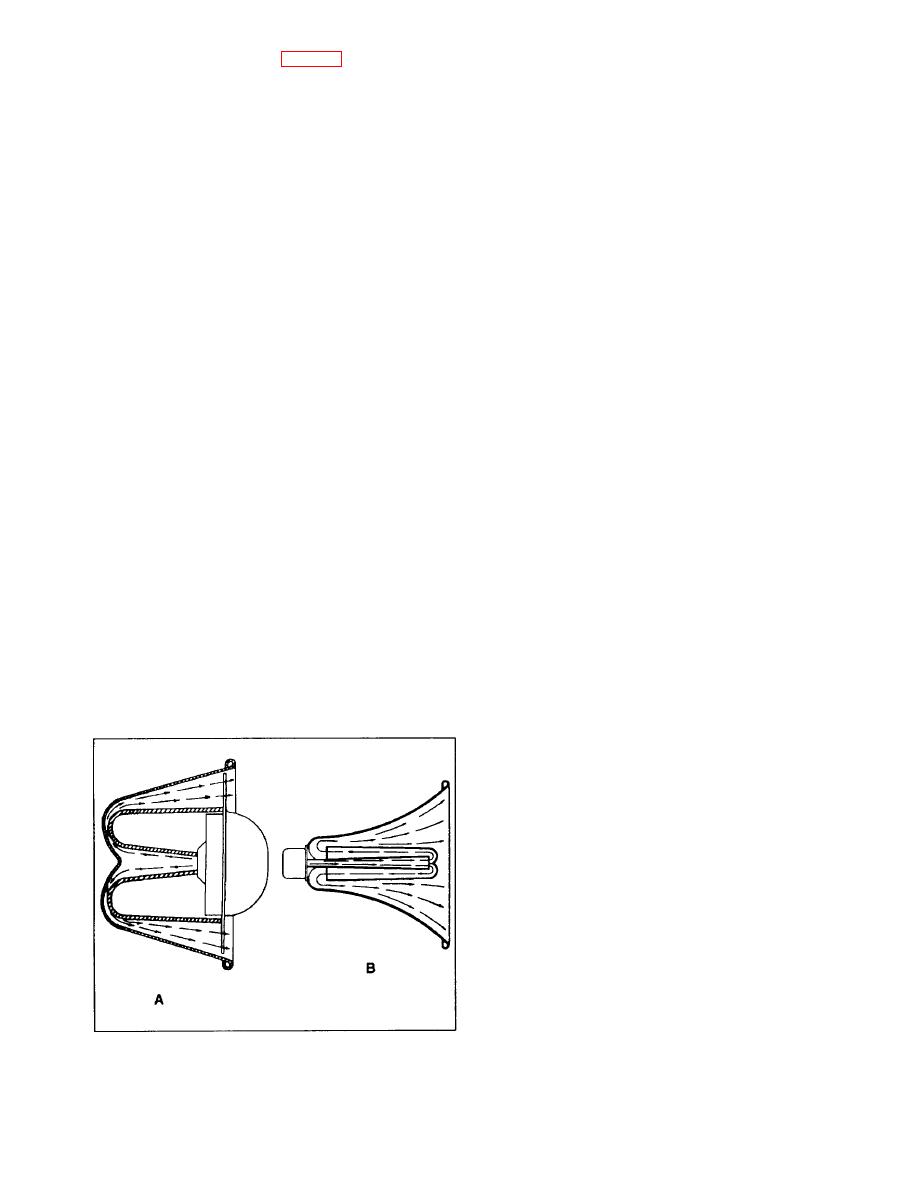 |
|||
|
Page Title:
Figure 7-7.--Folded-horn loudspeaker. |
|
||
| ||||||||||
|
|
 in cross-sectional areas at folds or joints in the horn.
a folded-horn loudspeaker (fig. 7-7) is employed in
preference to a straight horn. There is a practical limit
Vibrations of the horn walls must be sufficiently damped
to the power that can be handled by a conventional
to avoid introducing irregularities into the response, as
driver unit. When extremely high sound intensities must
well as transient effects.
be produced, multiunit loudspeakers are employed in
DIRECTIVITY.-- The directivity of a loud-
which the units are coupled to individual horn sections
speaker is an important factor in determining the
that are combined mechanically into a common
loudspeaker assembly.
efficiency of the sound radiation over the listening area.
All practical forms of sound radiators exhibit some
Characteristics of Loudspeakers
directional effects. If a radiator is placed in free space
where the results are not affected by interfering
Loudspeakers are rated according to their (1)
reflections, the sound pressure at a given distance is not
frequency response, (2) directivity, (3) capacity, (4)
the same in all directions. The directivity of a
efficiency, and (5) impedance.
loudspeaker is a function of both frequency and the size
of the horn mouth of the loudspeaker. Thus, a
cases, the frequency response of the loudspeaker is the
loudspeaker becomes more directional with increasing
limiting factor in the overall response of a sound system.
frequency because of the shorter wavelength, and a
For direct radiators, the low-frequency response is
influenced by the (1) baffle or enclosure, (2) diameter
direct radiator or horn mouth of large size is more
of the cone, (3) ability of the cone and voice coil to
directional than one of smaller size. These factors of
execute large amplitudes of vibration, and (4) strength
frequency and size are interrelated in that the size
of the magnetic field in the air gap. The high-frequency
becomes a factor relative to the wavelength of the sound
response is limited by the mass of the voice coil and
being transmitted. Thus, the directional pattern of a
diaphragm.
small loudspeaker transmitting a high-frequency signal
For horn loudspeakers, the low-frequency response
(short wavelength) is similar to that of a large
is influenced principal y by the (1) basic horn formula
loudspeaker transmitting a low-frequency signal (long
employed, (2) flare, and (3) mouth dimensions. The
wavelength). In general, a horn loudspeaker of a given
high-frequency response is limited by the (1) mass of
mouth diameter is more directional than a direct radiator
the voice coil and the diaphragm, (2) phase effects
caused by differences in path lengths due to bends, and
of the same diameter, particularly at the low frequencies.
(3) impedance irregularities caused by sudden changes
The directivity of a horn loudspeaker is also
dependent upon the rate of flare; that is, the directivity
increases as the flare is made more gradual (longer
horn). If a rectangular horn having a long narrow mouth
(in terms of wavelength) is mounted with the long
dimension of the mouth vertical, the radiation in the
horizontal plane corresponds to that of a small radiator
with a broad distribution pattern. The radiation in the
vertical plane acts as a large radiator with a relatively
narrow beam. In other words, the horn is made relatively
much less directional in the horizontal plane than in the
vertical plane, It is obvious that the reverse is true if the
horn is turned so that the long dimension of the mouth
is horizontal. Thus, the sound energy is flattened out in
a plane at right angles to the long dimension of the
loudspeaker mouth. This principle is used to obtain the
required directional characteristics for efficient
high-intensity reproduction on the flight decks of
aircraft carriers.
|
|
Privacy Statement - Press Release - Copyright Information. - Contact Us |